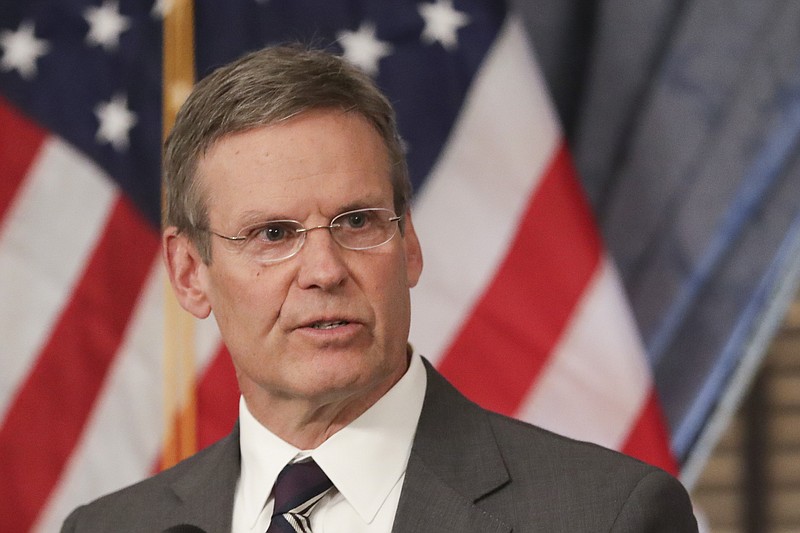Minutes after Tennessee Gov. Bill Lee began his Friday news conference to talk about his plan for a "slow, measured, stepped approach to reopening Tennessee from its three-week stay-at-home order, The number of America's COVID-19 deaths edged past 50,000.
Asked by reporters what would happen if new cases of the novel coronavirus rise next week after businesses reopen, the governor said state officials will be watching "the data - the same data" they watched a month ago before installing safer-at-home and, on April 2, stay-at-home orders. Lee and state health commissioner, Lisa Piercey, said they will continue to "watch the trends."
Let's review our state's COVID-19 trend.
* On Thursday, April 2, when the governor ordered Tennesseans to stay home for two weeks unless they were engaged in "essential activities or essential services," the number of COVID-19 cases stood at 2,845, with 32 deaths, according to the Tennessee Department of Health's daily virus update.
In Hamilton County, where Andy Berke, the mayor of Chattanooga, already had closed businesses citywide, confirmed cases numbered 52, with three deaths.
* On Monday, April 13, Lee extended his stay-at-home mandate, saying the state was gaining ground on the outbreak and the daily "growth rate" of positives had fallen to and remained at its lowest point since the virus was first confirmed in Tennessee. At that point, Tennessee's confirmed cases had nearly doubled to 5,610, and deaths had more than tripled - to 109.
In Hamilton County, where County Mayor Jim Coppinger had just days before issued a stay-home order, confirmed cases stood at 109, with a dozen deaths.
* And Friday, as Lee formalized guidelines for reopening the state, Tennessee cases rose to 8,726 - up 460 from the day before and up 870 since Wednesday - with 168 deaths.
In Hamilton County, cases were up to 141, with 13 deaths.
But in Friday's news briefing, Lee and state's tourism commissioner Mark Ezell, didn't mention any of those numbers. The only numbers the governor and Ezell detailed were about money and jobs.
The governor characterized the rise in COVID-19 cases - an increase of 190% over three weeks, by the way - as a good trend, adding that for more than the past two weeks the state had seen "a steady downward trajectory in the growth rate of COVID-19 cases."
The growth rate, he said. Not cases. He didn't show that growth rate data, or describe it further.
"While our health outlook, thankfully, continues to show signs of improvement our economic outlook is very different," Lee said.
As of this week, 15 percent of Tennessee's workforce filed unemployment claims.
"That's more than 400,000 Tennesseans without a job," Lee said. In March alone, some of the state's largest industries, "like hospitality," saw an $870 million loss in revenues.
State officials are predicting a $5 billion loss in the gross domestic product in Tennessee this fiscal year, he added.
Thus, he's offering "the Tennessee Pledge" - Tennessee's guidelines for reopening.
"It includes specific recommendations which enable most businesses to reopen responsibly without the burden of heavy mandates," the governor said.
Here's a smattering: Restaurants are asked to keep tables at least six feet apart, keep the bars closed and not have live music. Employees in restaurants and retail stores are asked to wear masks and gloves.
Some businesses, such as tattoo parlors, barbershops and nail salons, will remain closed for at least the next two weeks.
And, yes, the governor is "trusting," again. The state will not enforce the guidelines. Rather, we will trust businesses and consumers to operate safely.
Hamilton County's Mayor Coppinger and seven local municipalities already have signed on to follow the governor's plan.
Thankfully, Chattanooga Mayor Andy Berke has said he will follow "data not dates" and will not set an "arbitrary" reopening date, meaning Berke's restrictions spelled out in a series of executive orders earlier in the pandemic will still be in place within city limits.
Berke's Chief of Staff, Kerry Hayes, told reporters during a local COVID-19 task force briefing on Tuesday that he expects it will be around May 1 before the city sees the data from only recently increased testing. It is that data, he said, that will give city officials enough information to allow them to consider a time frame for reopening.
We understand the frustration of people who want to get back to work. And we understand the fear of not being able to make rent or a house payment or pay for a full grocery order.
But let's also acknowledge lots of unemployed workers have recently received their $1,200 or more in stimulus/relief money, and they are beginning to draw beefed up unemployment checks. More is on the way from another stimulus/rescue package enacted Friday.
A sickened workforce can't work either. And a restaurant at half capacity for a clientele too afraid to eat out won't cover the cost of cranking up the stoves and griddles.
"If people don't feel comfortable leaving their houses, and we don't actually get any economic activity out of the reopening process, then we're intensifying the economic crisis," said Marianne Wanamaker, an associate professor of economics at the University of Tennessee and a research associate at the National Bureau of Economic Research.
Tennessee and Hamilton County are reopening too soon.
And that may be even more dangerous than anything we've yet seen - both for our health and our economy.
